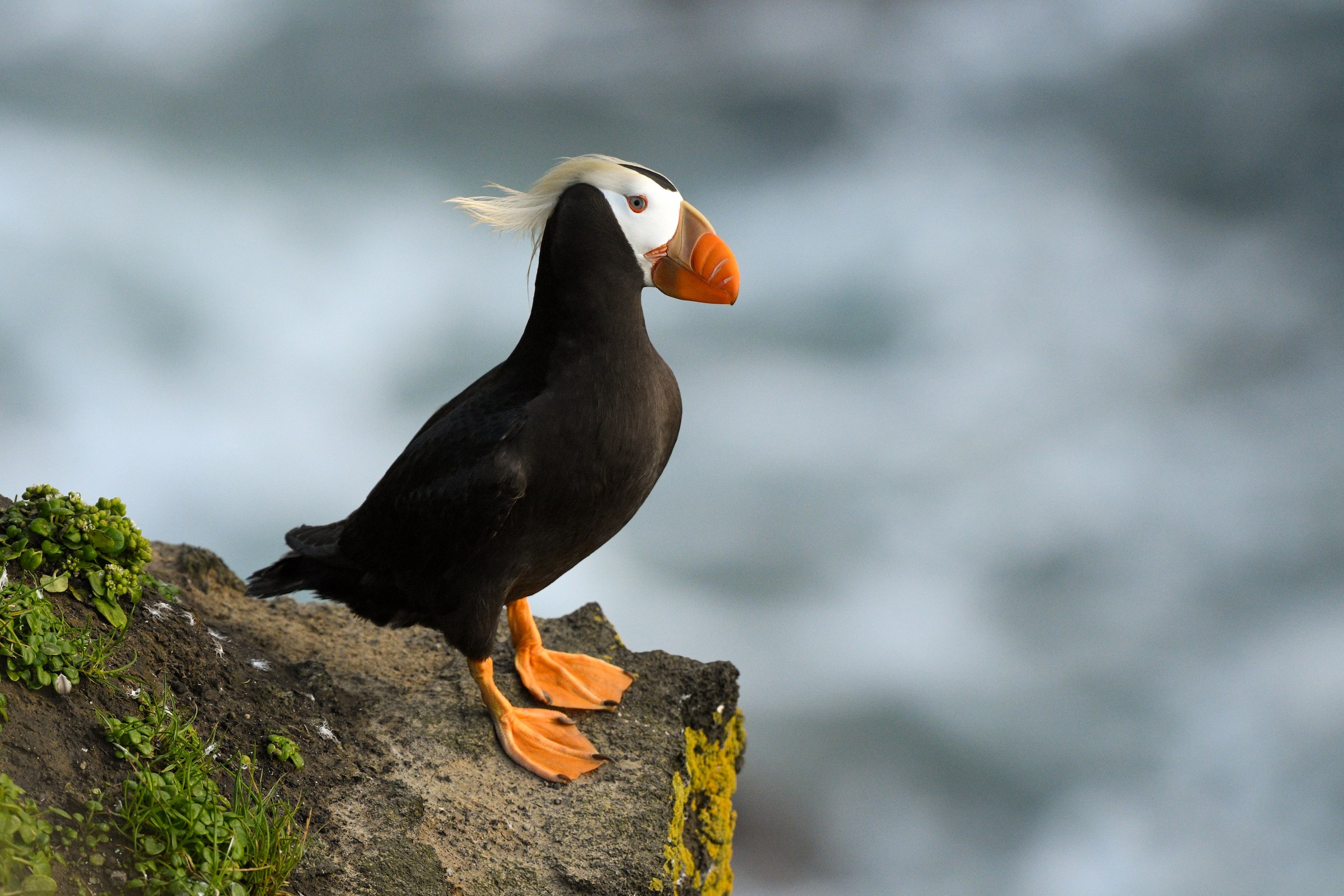The Captivating Tufted Puffin ===
The tufted puffin (Fratercula cirrhata) is a bird species that has captured the fascination of birdwatchers and nature enthusiasts alike. These charismatic seabirds are known for their distinctive appearance, with their striking orange beak, vibrant plumage, and iconic tufts of feathers on either side of their heads. Found along the coastlines of the North Pacific, from Alaska to Japan, these fascinating creatures have a complex life that is worth exploring in detail.
=== Habitat and Distribution: Where Puffins Call Home ===
Tufted puffins are primarily found in the northern regions of the Pacific Ocean. They nest and breed on offshore islands and rocky cliffs, where they can access their preferred diet of fish. From the Aleutian Islands in Alaska to the coasts of British Columbia, Washington, Oregon, and California, these birds have established colonies in various coastal habitats. They also inhabit islands off the coast of Japan and Russia. Their choice of habitat is dictated by the availability of suitable nesting sites, which are often burrows in the ground or crevices in cliffs.
=== Physical Characteristics: A Closer Look at Puffin Features ===
The tufted puffin stands out with its distinct black and white plumage. Its most notable feature is its large, colorful beak that transitions from bright red at the base to yellow towards the tip. During the breeding season, their facial feathers develop into long tufts on both sides of their head, giving them their characteristic look. These tufts are shed after the breeding season. Adult tufted puffins measure about 14 inches in length and have a wingspan of approximately 25 inches. They have sturdy legs and webbed feet that make them adept swimmers and divers.
=== Feeding Habits: Understanding Puffin’s Diet and Hunting Techniques ===
Puffins are skilled hunters, relying on their well-adapted beaks to catch small fish, such as herring and sand lance. They dive underwater, using their wings to propel themselves, and pursue their prey up to 200 feet below the surface. With their specialized beaks, they can catch multiple fish at once and carry them crosswise in their mouths, allowing them to capture a considerable amount of food in a short period. Puffins are also known to supplement their diet with marine invertebrates, such as squid and crustaceans.
=== Breeding Behavior: Insights into Puffins’ Mating and Nesting ===
Breeding season brings a flurry of activity to puffin colonies. Male puffins display their brightly colored beaks and engage in courtship rituals to attract mates. Once a pair is formed, they establish a nesting site in a burrow or crevice. Puffins are monogamous, returning to the same partner and nesting site year after year. The female puffin will lay a single egg, which both parents take turns incubating for approximately 40 days. After hatching, the chick will remain in the nest, cared for by both parents, until it is ready to fledge.
=== Life Cycle: From Egg to Fledgling – Puffin’s Journey ===
The life cycle of a tufted puffin begins with the hatching of the egg. The chick is born helpless and relies on its parents for warmth, protection, and food. Both parents take turns feeding the chick by regurgitating fish into its mouth. As the chick grows, its parents gradually decrease their feeding visits, encouraging it to become more independent. After approximately 45 days, the chick will fledge, leaving the nest and venturing out to sea for the first time. It will spend the following years at sea, gradually maturing and developing the characteristics of an adult puffin.
=== Conservation Status: The Efforts to Protect Puffin Populations ===
While tufted puffins are not currently considered endangered, the overall population of these birds has been in decline in recent years. Various organizations and researchers are working tirelessly to study and protect puffin populations. Efforts include monitoring nesting sites, implementing conservation measures, and raising awareness about the importance of preserving the puffin’s natural habitat. It is crucial to ensure that these beautiful birds continue to thrive and enchant future generations.
=== Threats to Puffins: Human Impact and Environmental Factors ===
Puffins face several threats that contribute to their declining numbers. Overfishing reduces the availability of their main food sources, making it harder for adult puffins to find enough prey to sustain themselves and their chicks. Pollution, including oil spills, can harm puffins and disrupt their breeding habitats. Climate change also poses a significant threat, as it alters ocean currents and affects the distribution of fish. Additionally, invasive species, such as rats and mink, can prey on puffin eggs and chicks, leading to reduced breeding success.
=== Puffins and Humans: Interactions and Ecotourism Opportunities ===
Tufted puffins have become a popular attraction for birdwatchers and wildlife enthusiasts. Many coastal areas that host puffin colonies offer ecotourism opportunities, allowing visitors to observe these birds in their natural habitat without disturbing their nesting grounds. Responsible tourism practices ensure that human interactions with puffins are minimal and respectful, minimizing any negative impact on their behavior or breeding success. By witnessing the captivating behaviors of puffins, visitors gain a deeper appreciation for these incredible seabirds and the need to protect their fragile environment.
Appreciating the Enchanting World of Puffins ===
The tufted puffin’s captivating appearance and intriguing behaviors make it a species that continues to fascinate researchers and nature enthusiasts. By understanding their habitat, physical characteristics, feeding habits, breeding behavior, and life cycle, we gain insight into the intricacies of their lives. However, it is essential to acknowledge the threats they face and actively work towards preserving their populations. By appreciating the enchanting world of puffins, we can strive to protect these majestic birds and ensure their place in the natural tapestry of our planet.

